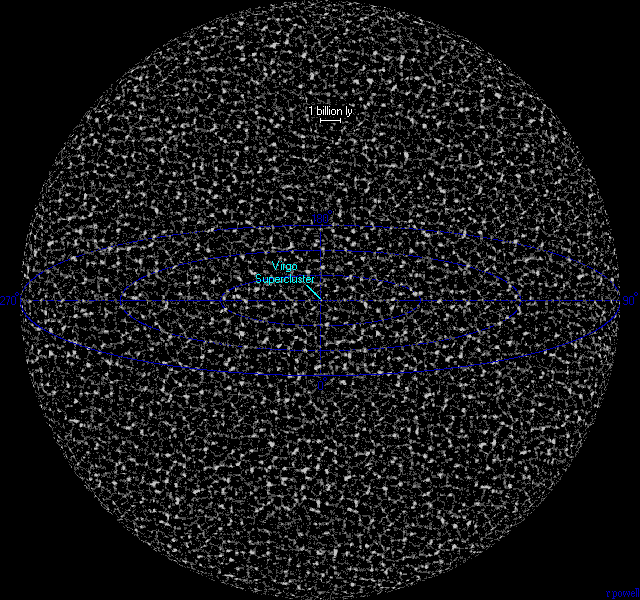
Credit: Richard Powell, source: atlasoftheuniverse.com.
Published under the terms of the Creative Commons Attribution-ShareAlike 2.5 License.
The observable universe is the region of space bounded by a sphere, centered on the observer, that is small enough that we might observe objects in it, i.e. there has been sufficient time for light emitted by an object to arrive at the observer. Every position has its own observable universe which may or may not overlap with the one centered around the Earth.
The word observable used in this sense has nothing to do with whether modern technology actually permits us to detect radiation from an object in this region. It simply means that it is possible for light or other radiation from the object to reach an observer on earth. In practice, we can only observe objects as far as the surface of last scattering, before which the universe was opaque to photons. However, it may be possible to infer information from before this time through the detection of gravitational waves.
The universe versus the observable universe
Both popular and professional research articles in cosmology often use the term “universe” to mean “observable universe”. This can be justified on the grounds that we can never know anything by direct experimentation about any part of the universe that is causally disconnected from us, although many credible theories, such as cosmic inflation require a universe much larger than the observable universe. No evidence exists to suggest that the boundary of the observable universe corresponds precisely to the physical boundary of the universe (if such a boundary exists); this is exceedingly unlikely in that it would imply that the Earth is exactly at the center of the universe, in violation of the cosmological principle. It is likely that the galaxies within our visible universe represent only a minuscule fraction of the galaxies in the universe.
It is also possible that the universe is smaller than the observable universe. In this case, what we take to be very distant galaxies may actually be duplicate images of nearby galaxies, formed by light that has circumnavigated the universe. It is difficult to test this hypothesis experimentally because different images of a galaxy would show different eras in its history, and consequently might appear quite different. A 2004 paper claims to establish a lower bound of 24 gigaparsecs (78 billion light-years) on the diameter of the universe, based on matching-circle analysis of the WMAP data.
Size of the observable universe
The comoving distance from the Earth to the edge of the visible universe (also called cosmic light horizon) is about 14 billion parsecs (46.5 billion light-years) in any direction. This defines the comoving radius of the observable universe. The observable universe is thus a sphere with a diameter of 28-29 billion parsecs (92–94 billion light-years).
The figures quoted above are distances now (in cosmological time), not distances at the time the light was emitted. For example, the cosmic microwave background radiation that we see right now was emitted about 13.7 billion years ago by matter that has, in the intervening time, condensed into galaxies. Those galaxies are now about 46 billion light-years from us, but at the time the light was emitted, that matter was only about 40 million light-years away from the matter that would eventually become the Earth.
